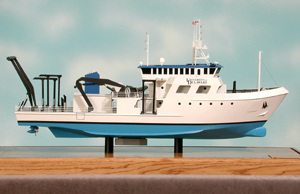|
 The University of Delaware is planning to build a new, 138-foot, state-of-the-art research vessel. At its anticipated completion in 2006, the new ship will replace UD’s long-sailing flagship, the 120-foot R/V Cape Henlopen, which has been in continuous service to the oceanographic community since 1976. The University of Delaware is planning to build a new, 138-foot, state-of-the-art research vessel. At its anticipated completion in 2006, the new ship will replace UD’s long-sailing flagship, the 120-foot R/V Cape Henlopen, which has been in continuous service to the oceanographic community since 1976.
“While the Cape Henlopen has served admirably, averaging 180 days at sea per year on a variety of missions, many of the ship’s systems are now rapidly growing obsolete,” Matthew Hawkins, director of marine operations at the University's College of Marine Studies, said.
“Marine research has expanded from simple sampling operations to complex, multidisciplinary studies,” he added. “Today’s research vessel requires a higher level of sophistication, including greater onboard lab space, lower emissions and operating noise, enhanced positioning systems and ship-to-shore communication, and the ability to handle remotely operated vehicles and other underwater robots.”
The new vessel will continue to operate as amember of the nation's academic research fleet via the University-National Oceanographic Laboratory System (UNOLS), a consortium of 64 academic institutions and national research laboratories. One of UNOLS’ chief functions is to ensure the efficient scheduling of scientific cruises aboard the 28 research vessels located at 21 of its member institutions.
As a UNOLS vessel, UD’s research ship has assisted scientists throughout the Mid-Atlantic region with missions ranging from water quality assessments of the Delaware Bay and data buoy deployments in the Chesapeake Bay to shark behavioral studies along the Atlantic coast. Funds to support these scientific studies and operate the ship come primarily from the National Science Foundation, the Office of Naval Research, and the National Oceanic and Atmospheric Administration.
The new ship will cover virtually the same operating range as the R/V Cape Henlopen, primarily the Delaware and Chesapeake bays and adjacent coastal waters with occasional work as far north as the Gulf of Maine, as far south as Florida, and as far east as Bermuda. However, the new ship will be larger, quieter, more energy-efficient, and more flexible in design than its predecessor.
“We convened a panel of ship users from a range of scientific disciplines and academic institutions to garner their input,” Hawkins said. “We asked these ship users to ‘gaze into their crystal ball’ and project what their research needs will be in the future. In addition, we consulted with the UNOLS Fleet Improvement Committee, which has added a significant global perspective to our design stage, ensuring that it meshes with the national plan for fleet capability and renewal.”
UD’s new research vessel is being designed by Bay Marine, Inc., in Barrington, R.I. While many of the design details will be developed during the next two years, Hawkins said the new ship will be roughly 138 feet long with a 33-foot beam and 9-foot draft. Its “endurance,” or maximum length of time at sea, will be approximately 20 days, and its range will be 3,000 nautical miles.
A modular design will enhance the ship’s flexibility. Hatches will be located throughout the deck to gain access to equipment below, minimizing the need for costly shipyard “down time” for equipment installation and reconfiguration. In addition to the laboratories built into the ship itself, the new vessel will be capable of carrying two, 20-foot portable vans that may be used as custom laboratories at sea.
While the new ship currently is being designed to operate under diesel-electric power, Hawkins said that fuel-cell technology is under consideration. Fuel cells are electrochemical devices that convert hydrogen-based fuels directly to electrical energy without combustion, providing a highly efficient, low-polluting method of power generation compared to traditional diesel engines.
“Fuel-cell technology is still in its infancy for marine applications, but it has great potential,” Hawkins said. “While it may not be mature enough to incorporate during construction of the ship in the next few years, one advantage of the vessel’s modular design is that it will allow this technology to be added at a later date.”
Noise Control Engineering of Billerica, Mass., will ensure that the ship will be as quiet as possible when under way, in keeping with the high standards recommended in the International Convention for Exploration of the Seas. These standards are based on the hearing ability of fish and were adopted so that during science operations, the ship itself does not influence the behavior of the fish being studied.
Hawkins said that low noise generation and low emissions are major goals of the new ship. While acceptable levels of emissions for a modern research vessel are still being investigated, he said the new EPA goals for marine propulsion are considered “a minimum.”
“The University of Delaware is committed to operating a coastal vessel as a service to the scientific community in the Mid-Atlantic region,” he said. “We are working to design a first-class ship that will advance marine research and have as little impact as possible on its environment during sampling.”
Detailed design of the vessel will continue over the next two years with scientific input incorporated at key points in the process. Construction of the new ship is projected to begin in mid-2004, with delivery of the new vessel at the end of 2005. After a short transition period in 2006, the new vessel will begin service, and the R/V Cape Henlopen will be retired.
Funding for the new vessel will be provided by the University of Delaware, private donations, the National Science Foundation, and the Office of Naval Research.
For more information, please visit www.ocean.udel.edu/level1/ship/vessels/rvchreplacement on the UD College of Marine Studies Web site, or contact Matthew Hawkins at hawkins@udel.edu or (302) 645-4341.
May 14, 2002
|

